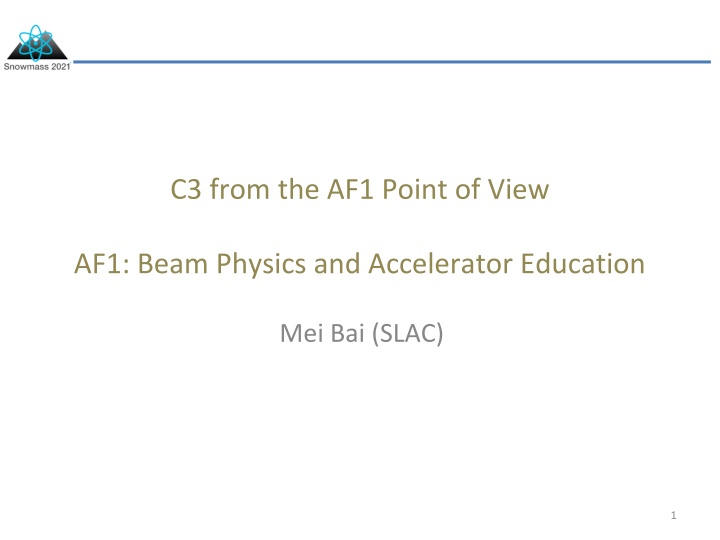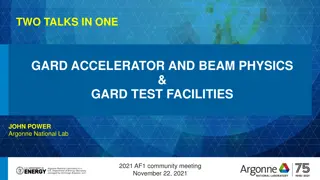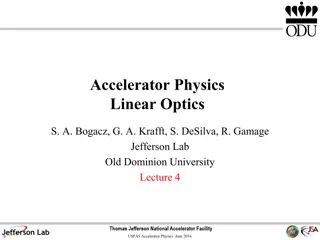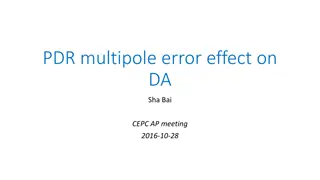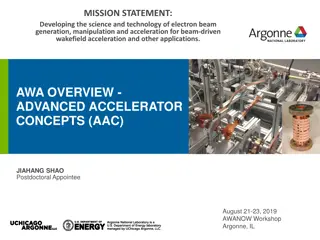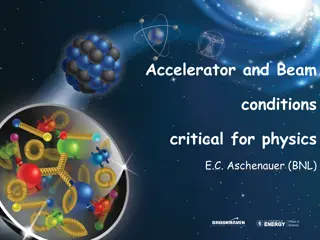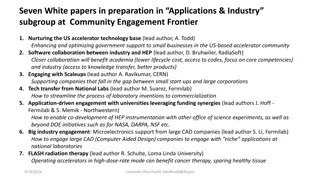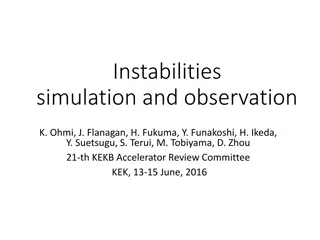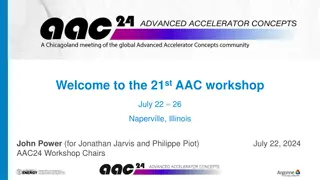Recommendations for Advancing Beam Physics and Accelerator Education
The exploration of new physics demands future accelerators beyond 1 TeV lepton colliders and 100 TeV hadron colliders, requiring luminosity in a specific range. Various challenges, including reaching quantum limits, face conventional RF-based beams. The pursuit of disruptive acceleration technologies, like plasma wake field acceleration, holds promise in achieving ultimate beam parameters. Key recommendations include establishing a decadal roadmap for accelerator and beam physics research, reinvigorating beam physics research programs, and enhancing US accelerator test facilities. Education, outreach, and diversity initiatives are also integral to advancing this field.
Download Presentation

Please find below an Image/Link to download the presentation.
The content on the website is provided AS IS for your information and personal use only. It may not be sold, licensed, or shared on other websites without obtaining consent from the author.If you encounter any issues during the download, it is possible that the publisher has removed the file from their server.
You are allowed to download the files provided on this website for personal or commercial use, subject to the condition that they are used lawfully. All files are the property of their respective owners.
The content on the website is provided AS IS for your information and personal use only. It may not be sold, licensed, or shared on other websites without obtaining consent from the author.
E N D
Presentation Transcript
C3 from the AF1 Point of View AF1: Beam Physics and Accelerator Education Mei Bai (SLAC) 1
AF1: Beam Physics and Accelerator Education 04: Physics Limits of Ultimate Beams 01: Education, Diversity and Outreach Dedicated workshop (joint with AF4, AF6, and Aries) to discuss ultimate beam parameters such as energy, intensity, brilliance, beam power on-target allowed by the fundamental laws of physics. Discuss practical limits from engineering and technology. Dedicated meeting (workshop) Invite all LoI contributors Discuss issues and propose steps Date: Target October Venue: online 04 Venue: online Co-Org with: AF4, AF6, & Aries 03: Computational Tools & Machine Learning 01 03 02: Research Center/Facility Discussion forum to clarify needs of test/R&D facilities to support concept R&D, training, and educational needs. Propose joint with Computational Frontier to cover tools extending modeling capabilities, potential ML impacts, education, and more efficient use of resources. 02 Venue: online Co-Org with AF4, AF6, etc Co-Org with: Comp Frontier
Summary The exploration of new physics calls for future colliders in beyond 1 TeV lepton colliders, and 100 TeV hadron colliders. Both cases require luminosity in the range of 1030?? 2? 1~ 1036?? 2? 1 The conventional RF acceleration-based beams so far are not yet at the quantum limit, but are facing a lot of challenges that require substantial R&Ds The ongoing plasma wake field acceleration or other disruptive acceleration technology could have the potential to reach the ultimate beams at the quantum limit Continue the technology exploration Need test facilities Need people 3
AF1 Recommendations Establish a decadal road map of accelerator and beam physics research in the DOE OHEP General Accelerator R&D (GARD) to address the four ABP grand challenges in beam intensity, beam quality, beam control and beam modeling Re-establish a program of beam physics research on general collider related topics, in particular, towards future e +e colliders and muon colliders Strengthen and expand capabilities of the US accelerator beam test facilities to maintain their competitiveness w.r.t. worldwide capabilities. Comprehensive recommendations for addressing work force -- Education: support for USPAS, universities and DOE traineeship programs -- Outreach: -- Yearly national undergrad-oriented recruiting class to draw in talent and Lab programs and expectations to deliver colloquia at universities -- Diversity Equity and Inclusion 4
Beam Test Facilities: Research Thrust & Capabilities (O(100) MeV energy drive beams, O(10) Petawatt drive lasers, O(1) Gigawatt RF power sources From J. Power, ANL, AF1 Report, July 21, 2021 5
Look from AF1 point of view Beam Physics Grand Challenges: High brightness beams -- low emittance photo injector, advanced beam dynamics for linac and beam delivery system -- strong synergy with X-FEL Beam control and modeling Acc. S&T Challenges: Novel HG RF structure and technologies Large scale LN cryogenic for accelerator system -- design, modeling, monitoring and controling Tunable permanent magnets C3 technology fundamental study and proof of the most critical structure performance C3 technology scale-up engineering design study and prototypes C3 technology scale-up minimum demonstration C3 technology scale-up small project full demonstration Key Technologies Manufacturability C3Demo facility will be complementary to the existing beam test facilities. Goals Accelerator Structure Klystron Cryogencis Cost study Demonstrate Linac The staged approach has strong synergies with other accelerator based scientific fields needs and can have strong near-term impact. Conceptual Design Technical Design Engineering Design Cost Cryogenics Conceptual Design Technical Design Demonstrate linac installation and commissioning Scope Technical Design Engineering Design A full dressed cryomodule Prototype The full realization will not only help to reduce the technical risks for the realization of C3, but also be the facility for accelerator and beam science R&D as well as training next generation workforce. Conceptual Design Cryomodule Prototype with Damping and w/wo HOM absorber Accelerator Structure Prototype with regular cell HALF Cryomodule Deliverables Demonstate linac test report and Design Study C3LC Demonstrate linac CDR Demonstrate linac TDR Demonstrate linac FDR 6
